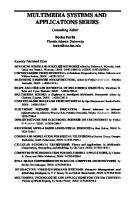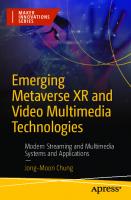Multimedia Data Processing and Computing (Innovations in Multimedia, Virtual Reality and Augmentation) 9781032469317, 9781032488882, 9781003391272
This book focuses on different applications of multimedia with supervised and unsupervised data engineering in the moder
121 3 6MB
English Pages 196 Year 2023
Table of contents :
Chapter 1 A Review on Despeckling of the Earth's Surface Visuals Captured by Synthetic Aperture Radar
Anirban Saha, Suman Kumar Maji, and Hussein Yahia
1.1 Introduction
1.2 Synthetic Aperture Radar (SAR)
1.2.1 SAR Geometry
1.2.2 Frequency Bands and Characteristics
1.2.3 Frequency Polarization, Penetration, and Scattering
1.3 Applications of Sar Visuals
1.4 Inevitable Challenges in Sar Imagery
1.5 Formulation of Sar Despeckling Problem
1.6 Sar Despeckling Methodologies
1.6.1 Filtration-based Techniques
1.6.2 Optimization-based Techniques
1.6.3 Hybrid Techniques
1.6.4 Deep Network–based Techniques
1.7 Comparative Analysis
1.8 Conclusion and Future Scope
References
Chapter 2 Emotion Recognition Using Multimodal Fusion Models: A Review
Archana Singh and Kavita Sahu
2.1 Introduction
2.2 Emotion Theories and Models
2.3 Emotion Recognition and Deep Learning
2.3.1 Facial Expression Recognition
2.3.2 Speech Emotion Recognition
2.3.3 Multimodel Emotion Recognition
2.4 Multimodal Emotion Recognition
2.4.1 Multimodal Emotion Recognition Combining Audio and Text
2.4.2 Multimodal Emotion Recognition Combining Image and Text
2.4.3 Multimodal Emotion Recognition Combining Facial and Body Physiology
2.4.4 Other Multimodal Emotion Recognition Models
2.5 Databases
2.5.1 Database Descriptions
2.6 Conclusion and Future Work
References
Chapter 3 Comparison of CNN-Based Features with Gradient Features for Tomato Plant Leaf Disease Detection
Amine Mezenner, Hassiba Nemmour, Youcef Chibani, and Adel Hafiane
3.1 Introduction
3.2 Proposed System for Tomato Disease Detection
3.2.1 Local Directional Pattern
3.2.2 Histogram of Oriented Gradient (HOG)
3.2.3 Convolutional Neural Network-based Features
3.2.4 Support Vector Machine–based Classification
3.3 Experimental Analysis
3.4 Conclusion
References
Chapter 4 Delay-sensitive and Energy-efficient Approach for Improving Longevity of Wireless Sensor Networks
Prasannavenkatesan Theerthagiri
4.1 Introduction
4.2 The Internet of Things
4.3 Routing Protocol for Low-Power and Lossy Networks
4.4 Related Work
4.5 Energy and Time Efficiency Network Model
4.5.1 Energy Efficiency Network Model
4.5.2 Time Efficiency Network Model
4.6 Results and Analysis
4.7 Conclusion and Future Scope
References
Chapter 5 Detecting Lumpy Skin Disease Using Deep Learning Techniques
Shiwalika Sambyal, Sachin Kumar, Sourabh Shastri, and Vibhakar Mansotra
5.1 Introduction
5.2 Material and Methods
5.2.1 Dataset
5.2.2 Research Methodology
5.2.3 Parameter Tuning
5.2.4 Proposed Architecture
5.3 Model Evaluation and Results
5.3.1 Environment of Implementation
5.3.2 Description of the Model
5.3.3 Results and Evaluation
5.4 Conclusion and Future Work
Acknowledgments
References
Chapter 6 Forest Fire Detection Using a Nine-Layer Deep Convolutional Neural Network
Prabira Kumar Sethy, A. Geetha Devi, and Santi Kumari Behera
6.1 Introduction
6.2 Literature Survey
6.3 Materials and Methods
6.3.1 About the Dataset
6.3.2 Proposed Methodology
6.4 Results and Discussion
6.5 Conclusion
References
Chapter 7 Identification of the Features of a Vehicle Using CNN
Neenu Maria Thankachan, Fathima Hanana, Greeshma K V, Hari K, Chavvakula Chandini, and Gifty Sheela V
7.1 Introduction
7.2 Literature Review
7.2.1 Image Capture
7.2.2 Identification and Detection of Vehicle
7.2.3 Automatic License Plate Recognition
7.2.4 Vehicle Logo Recognition
7.2.5 Vehicle Model Recognition
7.2.6 Re-identification of a Vehicle
7.3 Conclusion
7.4 Open Research Areas
References
Chapter 8 Plant Leaf Disease Detection Using Supervised Machine Learning Algorithm
Prasannavenkatesan Theerthagiri
8.1 Introduction
8.2 Literature Survey
8.3 Proposed System
8.3.1 Leaf Disease Image Database
8.3.2 Image Preprocessing
8.3.3 Feature Extraction
8.3.4 Classification
8.4 Results
8.4.1 Analysis of the Qualitative Data
8.5 Conclusion
References
Chapter 9 Smart Scholarship Registration Platform Using RPA Technology
Jalaj Mishra and Shivani Dubey
9.1 Introduction
9.2 Robotic Process Automation
9.3 Benefits of RPA
9.4 Background
9.5 Issues in Robotization of a Process
9.6 Tools and Technologies
9.6.1 RPA As a Rising Technology
9.6.2 Automation 360
9.7 Methodology
9.7.1 Implications in Existing System
9.7.2 Proposed System
9.7.3 Data Collection and Source File Creation
9.7.4 Creation and Structure of the Task Bot
9.8 Implementation
9.8.1 Setting User Credentials
9.8.2 Designing the Task Bot
9.8.3 Running the Task Bot
9.8.4 Implementing the Task Bot
9.8.5 Opening the CSV File
9.8.6 Launching the Scholarship Form
9.8.7 Populating the Web Form
9.8.8 Sending the E-mail
9.9 Results Analysis
9.10 Conclusion
References
Chapter 10 Data Processing Methodologies and a Serverless Approach to Solar Data Analytics
Parul Dubey, Ashish V Mahalle, Ritesh V Deshmukh, and Rupali S. Sawant
10.1 Introduction
10.1.1 Solar Thermal Energy
10.2 Literature Review
10.3 Data Processing Methodologies
10.3.1 Artificial Intelligence
10.3.2 Machine Learning
10.3.3 Deep Learning
10.4 Serverless Solar Data Analytics
10.4.1 Kinesis Data Streams
10.4.2 Kinesis Data Firehose
10.4.3 Amazon S3
10.4.4 Amazon Athena
10.4.5 Quicksight
10.4.6 F. Lambda
10.4.7 Amazon Simple Queue Service (SQS)
10.5 Conclusion
References
Chapter 11 A Discussion with Illustrations on World Changing ChatGPT – An Open AI Tool
Parul Dubey, Shilpa Ghode, Pallavi Sambhare, and Rupali Vairagade
11.1 Introduction
11.2 Literature Review
11.3 AI and ChatGPT
11.3.1 Code, Chat and Career: Pros and Cons of Using AI Language Models for Coding Industry
11.3.2 Jobs of Future: Will AI Displace or Augment Human Workers?
11.4 Impact of ChatGPT
11.4.1 Impact that ChatGPT Creates on Students
11.4.2 Impact that ChatGPT Creates on Teachers/Academicians
11.4.3 Impact that ChatGPT Creates on Parents
11.5 Applications of ChatGPT
11.6 Advantages of ChatGPT
11.7 Disadvantages of ChatGPT
11.8 Algorithms Used In ChatGPT
11.8.1 Illustration 1
11.8.2 Illustration 2
11.8.3 Illustration 3
11.9 Future of ChatGPT
11.10 Conclusion
References
Chapter 12 The Use of Social Media Data and Natural Language Processing for Early Detection of Parkinson's Disease Symptoms and Public Awareness
Abhishek Guru, Leelkanth Dewangan, Suman Kumar Swarnkar, Gurpreet Singh Chhabra, and Bhawna Janghel Rajput
12.1 Introduction
12.2 Literature Review
12.2.1 Parkinson's Disease Detection and Diagnosis
12.2.2 Social Media and Health Research
12.2.3 Natural Language Processing in Health Research
12.2.4 Early Detection of Health Issues Using Social Media and NLP
12.2.5 Public Awareness and Health Communication
12.3 Methodology
12.3.1 Data Collection
12.3.2 Data Preprocessing
12.3.3 Feature Extraction
12.3.4 Machine Learning Models
12.4 Results
12.4.1 Data Collection and Preprocessing
12.4.2 Feature Extraction
12.4.3 Machine Learning Models
12.4.4 Evaluation Metrics
12.4.5 Performance Results
12.4.6 Feature Importance
12.5 Discussion
12.6 Conclusion
References
Chapter 13 Advancing Early Cancer Detection with Machine Learning: A Comprehensive Review of Methods and Applications
Upasana Sinha, J Durga Prasad Rao, Suman Kumar Swarnkar, and Prashant Kumar Tamrakar
13.1 Introduction
13.2 Literature Review
13.3 Methodology
13.4 Results
13.5 Application of Research
13.6 Conclusion
References
Index
Chapter 1 A Review on Despeckling of the Earth's Surface Visuals Captured by Synthetic Aperture Radar
Anirban Saha, Suman Kumar Maji, and Hussein Yahia
1.1 Introduction
1.2 Synthetic Aperture Radar (SAR)
1.2.1 SAR Geometry
1.2.2 Frequency Bands and Characteristics
1.2.3 Frequency Polarization, Penetration, and Scattering
1.3 Applications of Sar Visuals
1.4 Inevitable Challenges in Sar Imagery
1.5 Formulation of Sar Despeckling Problem
1.6 Sar Despeckling Methodologies
1.6.1 Filtration-based Techniques
1.6.2 Optimization-based Techniques
1.6.3 Hybrid Techniques
1.6.4 Deep Network–based Techniques
1.7 Comparative Analysis
1.8 Conclusion and Future Scope
References
Chapter 2 Emotion Recognition Using Multimodal Fusion Models: A Review
Archana Singh and Kavita Sahu
2.1 Introduction
2.2 Emotion Theories and Models
2.3 Emotion Recognition and Deep Learning
2.3.1 Facial Expression Recognition
2.3.2 Speech Emotion Recognition
2.3.3 Multimodel Emotion Recognition
2.4 Multimodal Emotion Recognition
2.4.1 Multimodal Emotion Recognition Combining Audio and Text
2.4.2 Multimodal Emotion Recognition Combining Image and Text
2.4.3 Multimodal Emotion Recognition Combining Facial and Body Physiology
2.4.4 Other Multimodal Emotion Recognition Models
2.5 Databases
2.5.1 Database Descriptions
2.6 Conclusion and Future Work
References
Chapter 3 Comparison of CNN-Based Features with Gradient Features for Tomato Plant Leaf Disease Detection
Amine Mezenner, Hassiba Nemmour, Youcef Chibani, and Adel Hafiane
3.1 Introduction
3.2 Proposed System for Tomato Disease Detection
3.2.1 Local Directional Pattern
3.2.2 Histogram of Oriented Gradient (HOG)
3.2.3 Convolutional Neural Network-based Features
3.2.4 Support Vector Machine–based Classification
3.3 Experimental Analysis
3.4 Conclusion
References
Chapter 4 Delay-sensitive and Energy-efficient Approach for Improving Longevity of Wireless Sensor Networks
Prasannavenkatesan Theerthagiri
4.1 Introduction
4.2 The Internet of Things
4.3 Routing Protocol for Low-Power and Lossy Networks
4.4 Related Work
4.5 Energy and Time Efficiency Network Model
4.5.1 Energy Efficiency Network Model
4.5.2 Time Efficiency Network Model
4.6 Results and Analysis
4.7 Conclusion and Future Scope
References
Chapter 5 Detecting Lumpy Skin Disease Using Deep Learning Techniques
Shiwalika Sambyal, Sachin Kumar, Sourabh Shastri, and Vibhakar Mansotra
5.1 Introduction
5.2 Material and Methods
5.2.1 Dataset
5.2.2 Research Methodology
5.2.3 Parameter Tuning
5.2.4 Proposed Architecture
5.3 Model Evaluation and Results
5.3.1 Environment of Implementation
5.3.2 Description of the Model
5.3.3 Results and Evaluation
5.4 Conclusion and Future Work
Acknowledgments
References
Chapter 6 Forest Fire Detection Using a Nine-Layer Deep Convolutional Neural Network
Prabira Kumar Sethy, A. Geetha Devi, and Santi Kumari Behera
6.1 Introduction
6.2 Literature Survey
6.3 Materials and Methods
6.3.1 About the Dataset
6.3.2 Proposed Methodology
6.4 Results and Discussion
6.5 Conclusion
References
Chapter 7 Identification of the Features of a Vehicle Using CNN
Neenu Maria Thankachan, Fathima Hanana, Greeshma K V, Hari K, Chavvakula Chandini, and Gifty Sheela V
7.1 Introduction
7.2 Literature Review
7.2.1 Image Capture
7.2.2 Identification and Detection of Vehicle
7.2.3 Automatic License Plate Recognition
7.2.4 Vehicle Logo Recognition
7.2.5 Vehicle Model Recognition
7.2.6 Re-identification of a Vehicle
7.3 Conclusion
7.4 Open Research Areas
References
Chapter 8 Plant Leaf Disease Detection Using Supervised Machine Learning Algorithm
Prasannavenkatesan Theerthagiri
8.1 Introduction
8.2 Literature Survey
8.3 Proposed System
8.3.1 Leaf Disease Image Database
8.3.2 Image Preprocessing
8.3.3 Feature Extraction
8.3.4 Classification
8.4 Results
8.4.1 Analysis of the Qualitative Data
8.5 Conclusion
References
Chapter 9 Smart Scholarship Registration Platform Using RPA Technology
Jalaj Mishra and Shivani Dubey
9.1 Introduction
9.2 Robotic Process Automation
9.3 Benefits of RPA
9.4 Background
9.5 Issues in Robotization of a Process
9.6 Tools and Technologies
9.6.1 RPA As a Rising Technology
9.6.2 Automation 360
9.7 Methodology
9.7.1 Implications in Existing System
9.7.2 Proposed System
9.7.3 Data Collection and Source File Creation
9.7.4 Creation and Structure of the Task Bot
9.8 Implementation
9.8.1 Setting User Credentials
9.8.2 Designing the Task Bot
9.8.3 Running the Task Bot
9.8.4 Implementing the Task Bot
9.8.5 Opening the CSV File
9.8.6 Launching the Scholarship Form
9.8.7 Populating the Web Form
9.8.8 Sending the E-mail
9.9 Results Analysis
9.10 Conclusion
References
Chapter 10 Data Processing Methodologies and a Serverless Approach to Solar Data Analytics
Parul Dubey, Ashish V Mahalle, Ritesh V Deshmukh, and Rupali S. Sawant
10.1 Introduction
10.1.1 Solar Thermal Energy
10.2 Literature Review
10.3 Data Processing Methodologies
10.3.1 Artificial Intelligence
10.3.2 Machine Learning
10.3.3 Deep Learning
10.4 Serverless Solar Data Analytics
10.4.1 Kinesis Data Streams
10.4.2 Kinesis Data Firehose
10.4.3 Amazon S3
10.4.4 Amazon Athena
10.4.5 Quicksight
10.4.6 F. Lambda
10.4.7 Amazon Simple Queue Service (SQS)
10.5 Conclusion
References
Chapter 11 A Discussion with Illustrations on World Changing ChatGPT – An Open AI Tool
Parul Dubey, Shilpa Ghode, Pallavi Sambhare, and Rupali Vairagade
11.1 Introduction
11.2 Literature Review
11.3 AI and ChatGPT
11.3.1 Code, Chat and Career: Pros and Cons of Using AI Language Models for Coding Industry
11.3.2 Jobs of Future: Will AI Displace or Augment Human Workers?
11.4 Impact of ChatGPT
11.4.1 Impact that ChatGPT Creates on Students
11.4.2 Impact that ChatGPT Creates on Teachers/Academicians
11.4.3 Impact that ChatGPT Creates on Parents
11.5 Applications of ChatGPT
11.6 Advantages of ChatGPT
11.7 Disadvantages of ChatGPT
11.8 Algorithms Used In ChatGPT
11.8.1 Illustration 1
11.8.2 Illustration 2
11.8.3 Illustration 3
11.9 Future of ChatGPT
11.10 Conclusion
References
Chapter 12 The Use of Social Media Data and Natural Language Processing for Early Detection of Parkinson's Disease Symptoms and Public Awareness
Abhishek Guru, Leelkanth Dewangan, Suman Kumar Swarnkar, Gurpreet Singh Chhabra, and Bhawna Janghel Rajput
12.1 Introduction
12.2 Literature Review
12.2.1 Parkinson's Disease Detection and Diagnosis
12.2.2 Social Media and Health Research
12.2.3 Natural Language Processing in Health Research
12.2.4 Early Detection of Health Issues Using Social Media and NLP
12.2.5 Public Awareness and Health Communication
12.3 Methodology
12.3.1 Data Collection
12.3.2 Data Preprocessing
12.3.3 Feature Extraction
12.3.4 Machine Learning Models
12.4 Results
12.4.1 Data Collection and Preprocessing
12.4.2 Feature Extraction
12.4.3 Machine Learning Models
12.4.4 Evaluation Metrics
12.4.5 Performance Results
12.4.6 Feature Importance
12.5 Discussion
12.6 Conclusion
References
Chapter 13 Advancing Early Cancer Detection with Machine Learning: A Comprehensive Review of Methods and Applications
Upasana Sinha, J Durga Prasad Rao, Suman Kumar Swarnkar, and Prashant Kumar Tamrakar
13.1 Introduction
13.2 Literature Review
13.3 Methodology
13.4 Results
13.5 Application of Research
13.6 Conclusion
References
Index

- Author / Uploaded
- Suman Kumar Swarnkar
- J P Patra
- Tien Anh Tran
- Bharat Bhushan
- Santosh Biswas
- Similar Topics
- Computers
- Organization and Data Processing



![Multimedia and Virtual Reality: Designing Usable Multisensory User Interfaces [illustrated edition]
080583950X, 9780805839500, 9781410607157](https://ebin.pub/img/200x200/multimedia-and-virtual-reality-designing-usable-multisensory-user-interfaces-illustrated-edition-080583950x-9780805839500-9781410607157.jpg)




![Data Mining Multimedia, Soft Computing, and Bioinformatics [1 ed.]
0471460540, 9780471460541](https://ebin.pub/img/200x200/data-mining-multimedia-soft-computing-and-bioinformatics-1nbsped-0471460540-9780471460541.jpg)
